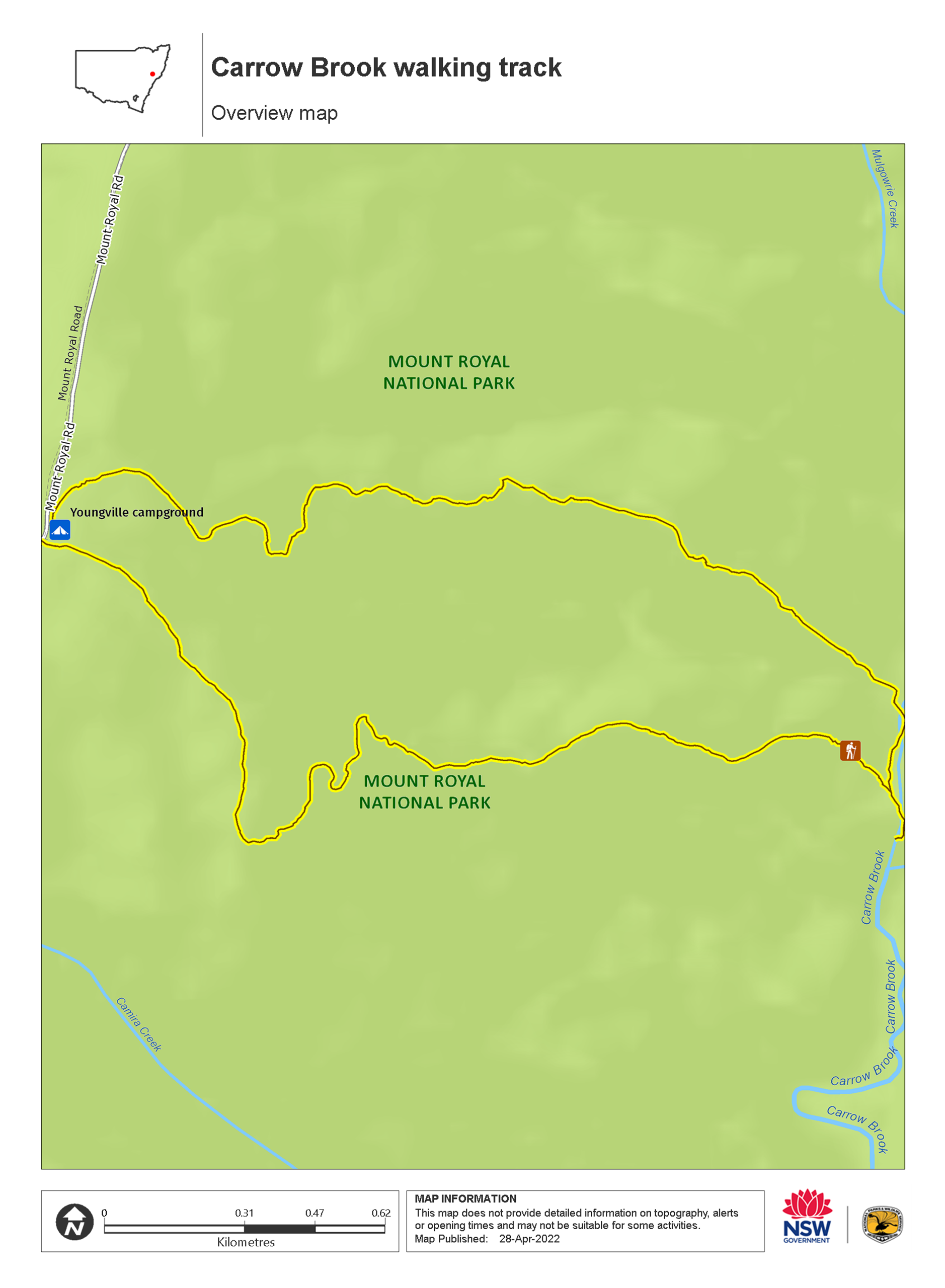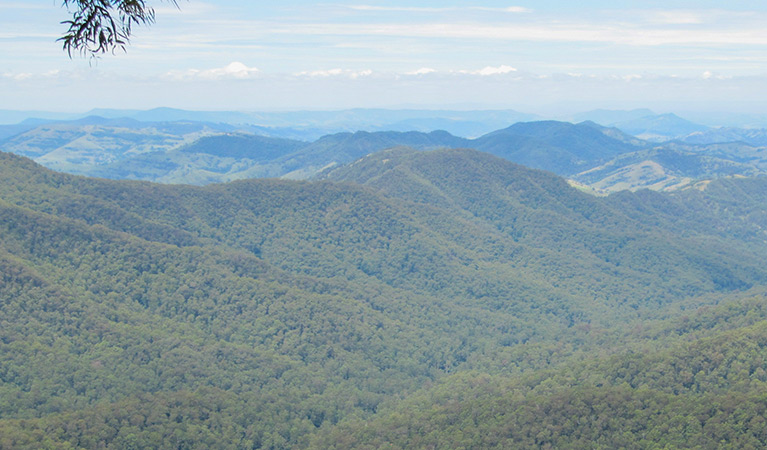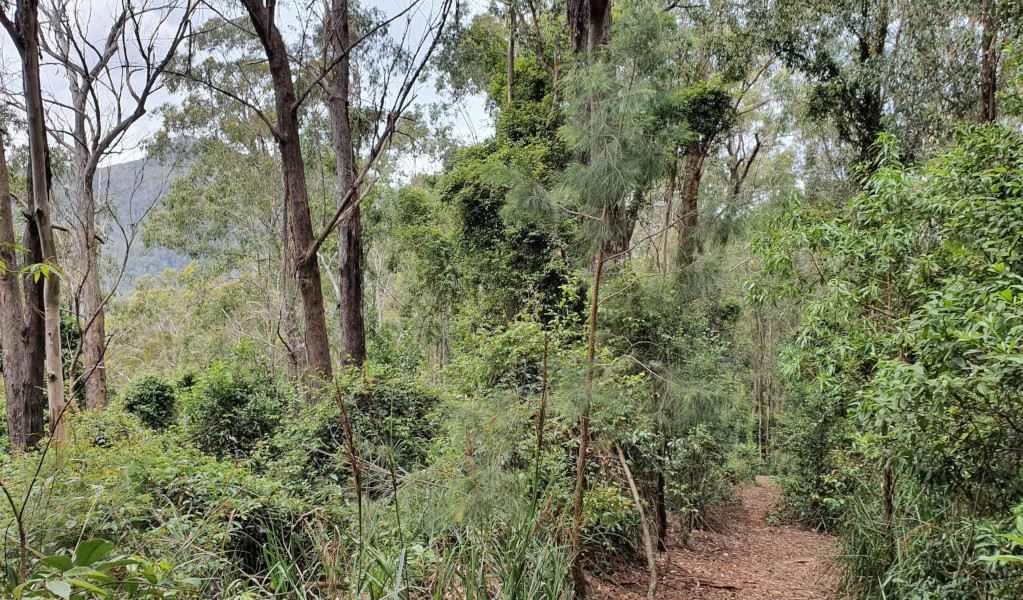Carrow Brook walking track
Mount Royal National Park
Overview
Carrow Brook walking track is a remote walk into the valleys of Mount Royal National Park, near Singleton. A challenging loop hike, it’s best suited to fit, experienced bushwalkers.
- Where
- Mount Royal National Park in North Coast, Country NSW
- Accessibility
- No wheelchair access
- Distance
- 6km loop
- Time suggested
- 2hrs 30min - 3hrs 30min
- Grade
- Grade 4
- Trip Intention Form
-
It's a good idea to let someone know where you're going. Fill in a trip intention form to send important details about your trip to your emergency contact.
- What to
bring - Drinking water, sturdy shoes, hat, suitable clothing, clothes for all weather conditions, first aid kit, sunscreen, snacks, topographic map, gps
- Please note
- This trail includes a very steep descent and ascent of 450m and requires a high level of fitness. Bushwalking experience is recommended.
- This is a remote walking track. It’s a good idea to bring a topographic map, GPS and first-aid.
- Weather can change quickly and dramatically in this area, so please ensure you’re well prepared.
If you’re looking for a challenge, then Carrow Brook walking track is for you. Starting from Youngville campground you’ll descend through the towering forest as you make your way to the tranquil waters of Mulgowrie Creek and Carrow Brook. The water’s edge is an ideal place to stop for a rest and some lunch before you tackle the steep climb back.
You’re sure to feel a sense of remoteness on this adventure, as you breathe in the fresh mountain air and enjoy the sights of tall eucalypts, giant blue gums and critically endangered scrub turpentine.
Don’t forget to look up. As well as the scenic views of Mount Royal and Mount Carrow through the forest canopy, there’s also a good chance you’ll spot glossy black cockatoos, varied sitellas and scarlet robins. And keep a lookout among the understory for long-nosed potoroo and parma wallabies.
Spring is a great time to tackle this walk. Temperatures are mild and wildflowers, like white paper daisies, are in bloom.
Map

Map legend

Local alerts
For the latest updates on fires, closures and other alerts in this area, see https://www.nationalparks.nsw.gov.au/things-to-do/walking-tracks/carrow-brook-walking-track/local-alerts
General enquiries
- National Parks Contact Centre
- 7am to 7pm daily
- 1300 072 757 (13000 PARKS) for the cost of a local call within Australia excluding mobiles
- parks.info@environment.nsw.gov.au
Park info
- in Mount Royal National Park in the North Coast and Country NSW regions
Mount Royal National Park is always open but may have to close at times due to poor weather or fire danger.
Visitor info
All the practical information you need to know about Carrow Brook walking track.
Maps and downloads
Learn more
Carrow Brook walking track is in Mount Royal National Park. Here are just some of the reasons why this park is special:
An important cultural place

The area now covered by Mount Royal National Park, Barrington Tops National Park and Barrington Tops State Conservation Area is the traditional land of the Biripi, Worimi, Geawegal, Wonaruah and Ungooroo People. Although these people were dispossessed of their land after European settlement of New South Wales, they continue to have a deep attachment to the country and an active interest in its management. This place contains important foods, medicinal plants, animal species and sacred sites.
Safe haven

The rich diversity of vegetation offers habitat for a wide range of birds and animals, many of which are rare and threatened. These include: the endangered hastings river mouse; the threatened parma wallaby (described by British naturalist John Gould way back in 1840 as 'shy' and 'cryptic'; and the vulnerable spotted-tailed quoll, which is the largest marsupial carnivore on mainland Australia. The old growth forest is also habitat for four large forest owls - masked, barking, powerful and sooty - all of which are threatened species. Mount Royal National Park has a variety of forest types and vegetation communities, ranging from shrubland to tall open forest and wet eucalypt forest. The most dominant form of vegetation is mid-altitude grassy forest with plentiful stands of New England blackbutt, Sydney blue gum and grey gum.
- Carrow Brook walking track Carrow Brook walking track is a remote walk into the valleys of Mount Royal National Park, near Singleton. A challenging loop hike, it’s best suited to fit, experienced bushwalkers.
Same as always

Mount Royal National Park is listed as part of the Gondwana Rainforests of Australia. Formerly known as the Central Eastern Rainforest Reserves, these include the most extensive areas of subtropical rainforest in the world, large areas of warm temperate rainforests and nearly all of the Antarctic beech cool temperate rainforest. Few places on earth contain so many plants and animals that remain relatively unchanged from their ancestors in fossil records.
The changing face

After government surveyors explored this area in the very early 1800s, the land soon became mined for gold, logged for its timber and used to graze lifestock. Small settlements established themselves on the plateau, mainly due to these agricultural opportunities. From the early 1900s, however, the area became increasingly popular for recreation and for scientific expeditions.

